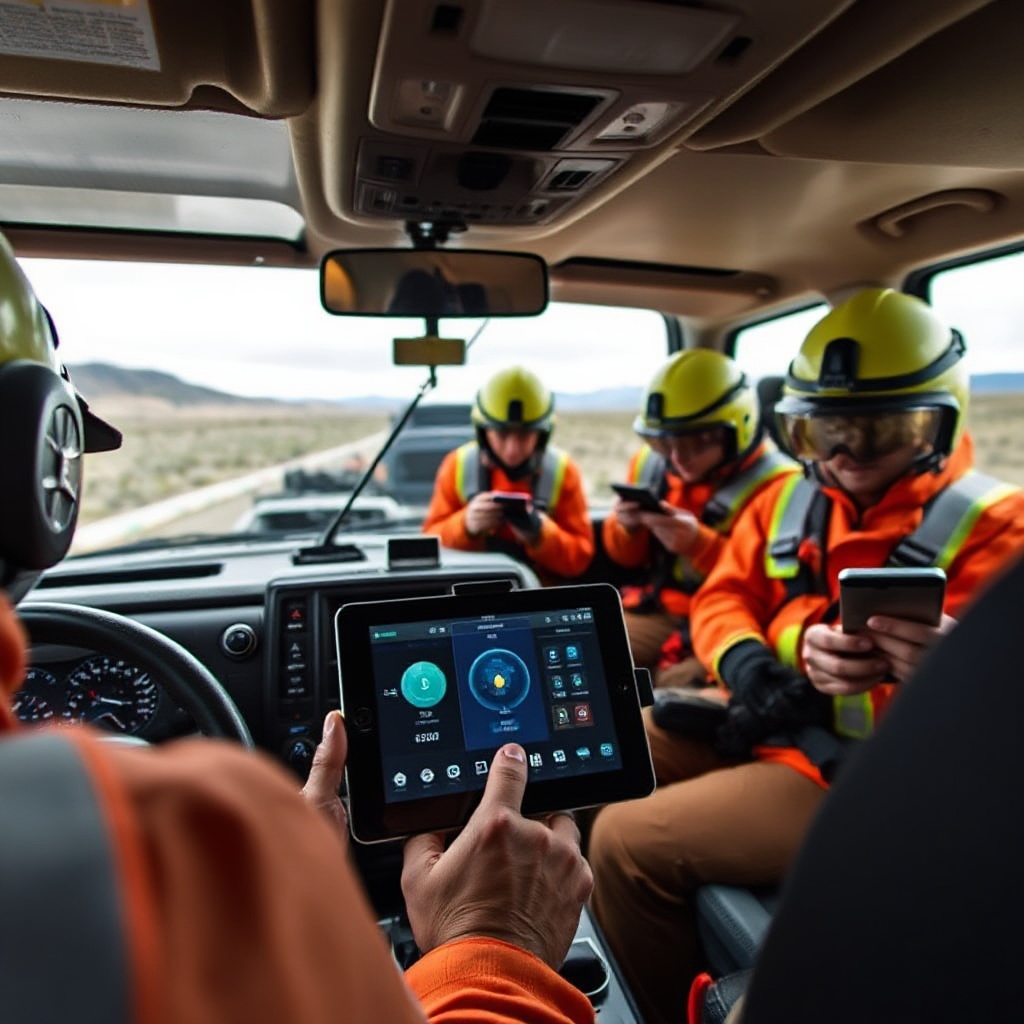
Satellite connectivity in vehicles proves life-saving during earthquakes, transforming emergency response in remote areas where traditional networks fail.

Drivetech Partners
The integration of satellite connectivity in vehicles like the Huawei Aito M9 has proven to be more than a luxury feature, demonstrating its life-saving potential during the devastating December 2023 earthquake in China's Qinghai and Gansu provinces. When conventional communication networks failed in remote areas, satellite-equipped vehicles maintained crucial links that facilitated rescue coordination, emergency response, and critical information sharing in environments where terrestrial networks were rendered useless.
Key Takeaways
The Huawei Aito M9's satellite communication system played a vital role during the December 2023 earthquake rescue operations in areas with no conventional network coverage
Over 3,800 rescue workers and 1,000+ machines were deployed during the Qinghai earthquake response, with satellite connectivity helping coordinate efforts
The Xinghe Communications System creates a 30-meter satellite hotspot around vehicles, extending emergency connectivity to rescue teams and other devices
Satellite-equipped vehicles can trigger automatic SOS calls and crash notifications without user intervention when cellular networks are unavailable
Beyond emergency response, satellite connectivity is transforming wilderness exploration and scientific research by enabling communications in previously isolated regions
The Delingha Rescue: How Satellite-Connected Vehicles Prove Critical in Network Blind Zones
In December 2023, a powerful earthquake struck China's Qinghai and Gansu provinces, leaving devastation in its wake. The remote Delingha region of Qinghai faced a particularly challenging scenario – not only was it severely impacted by the disaster, but its mountainous terrain created extensive "network blind zones" where conventional communication methods failed completely.
The poor terrestrial network infrastructure in these remote areas severely hampered coordination efforts. Rescue teams couldn't reliably communicate with command centers, share critical information, or coordinate resource deployment. In this dire situation, vehicles equipped with satellite connectivity became communication hubs that maintained vital links where cell towers had failed or never existed.

Response times saw significant improvements when satellite-equipped vehicles were deployed. Traditional rescue operations in network-isolated environments faced delays of hours or even days waiting for teams to physically return to areas with connectivity to report findings or request resources. With satellite-enabled vehicles, these communication gaps were eliminated, allowing for real-time coordination regardless of location.
The earthquake response mobilized over 3,800 rescue workers and more than 1,000 machines, while 14 tons of supplies were airlifted to affected areas. Throughout this massive operation, maintaining communication links proved to be as crucial as the physical resources deployed – highlighting why vehicles with reliable communication capabilities in remote areas represent a paradigm shift in emergency response.
Inside Huawei's Revolutionary Xinghe Communications System
The 2025 Aito M9 stands as China's first production vehicle with integrated satellite calling and messaging capabilities. This technological breakthrough is powered by Huawei's Xinghe Communications System, which fundamentally transforms how vehicles maintain connectivity in challenging environments.
At the core of this system is multi-mode networking – the vehicle intelligently and seamlessly switches between mobile data and satellite connections when conventional coverage disappears. This transition happens automatically, ensuring that navigation, emergency services, and communication remain uninterrupted even as drivers move through areas with varying network availability.
The "three-network connection" architecture represents a significant advance in vehicle connectivity. The system maintains simultaneous ground (cellular), Wi-Fi, and satellite connectivity options, with dual network dual-standby capabilities ensuring rapid switching between communication channels when needed. This redundancy is particularly valuable in life-threatening situations where communication failures could have dire consequences.
One of the most transformative features is the mobile satellite hotspot function, which extends connectivity to other devices within a 30-meter radius of the vehicle. This effectively turns the Aito M9 into a communication hub that can support multiple smartphones, tablets, and other devices in areas completely isolated from conventional networks.

The technical implementation relies on Huawei's HarmonyOS Smart Driving Unit, which serves as the central brain coordinating all vehicle systems, including the satellite communication capabilities. This integration allows for intelligent power management that balances communication needs with battery conservation – a critical consideration for emergency situations where power resources may be limited.
Emergency Response Evolution: From Manual Calls to Automated Satellite SOS
Conventional emergency systems have long suffered from a critical weakness – their dependence on unreliable mobile networks in rural areas. When accidents occur in remote locations, victims often find themselves in a desperate situation: physically injured and simultaneously cut off from help due to non-existent cellular coverage.
The Aito M9's satellite system represents a quantum leap forward with its automatic satellite emergency activation. When cellular networks are unavailable, the system can trigger SOS calls without requiring the user to know complex procedures or special equipment operation – a crucial advantage when occupants might be injured or in shock.
Vehicle sensors linked to satellite connections enable immediate crash notifications without user intervention. This means that even if passengers are unconscious or incapacitated, the vehicle can still alert emergency services with precise location data and crash severity information – minutes that can make the difference between life and death in critical injuries.
The support for multiple connected devices transforms how rescue teams operate in remote areas. Traditional operations required teams to return to areas with connectivity to coordinate efforts, but with the Aito M9's satellite network, entire rescue teams can maintain communication within a 30-meter radius of the vehicle. This allows for:
Real-time sharing of victim location and status updates
Coordination of medical resources and evacuation plans
Access to remote medical expertise through data sharing
Continuous communication between field teams and command centers
Extended search radius while maintaining connectivity
This system effectively represents the next generation of eCall enhancement, moving beyond basic emergency notification to create a comprehensive emergency communication platform that functions regardless of terrestrial network availability.
From Luxury Feature to Safety Standard: The Industry-Wide Transformation
The Aito M9 has established new connectivity benchmarks in the automotive industry, helping secure its position as China's best-selling luxury SUV over 500,000 yuan for eleven consecutive months. What began as a premium feature is rapidly becoming recognized as an essential safety component that could eventually be standardized across vehicle categories.
All Aito M9 models are scheduled for upgrade to Huawei's ADS 4.0 in 2025, further integrating advanced connectivity with autonomous driving capabilities. This convergence of technologies represents a fundamental shift in how we think about vehicle safety – moving from passive protection systems to active communication networks that can prevent accidents and expedite rescue when needed.
When comparing the Aito M9 with its predecessors (the M5 and M7) and competitors without satellite capability, the differences in emergency response potential become stark. While traditional luxury vehicles might offer superior comfort or performance, they remain effectively "stranded" in network blind zones – a limitation that can prove fatal in emergency situations.
The industry implications extend beyond individual safety to reshaping automotive safety regulations and cross-brand competition. As satellite connectivity demonstrates its life-saving potential, regulatory bodies may begin requiring redundant communication systems in vehicles – similar to how airbags and ABS evolved from luxury options to mandated safety features.
With Huawei's HarmonyOS serving as the foundation for these integrated communications systems, the company is positioning itself at the forefront of defining new vehicle connectivity standards that prioritize continuous communication regardless of environmental conditions.
Enabling Wilderness Exploration and Scientific Research
Adventure travelers exploring the vast landscapes of the Qinghai-Tibet Plateau and similar remote regions have long accepted extensive "network blind zones" as an unavoidable risk. The introduction of satellite-connected vehicles fundamentally changes this calculation, offering reliable communication even in the most isolated environments.
Real-time location sharing and emergency access transform safety parameters for wilderness exploration. Travelers can now venture further with the confidence that they can summon help if needed, share their exact coordinates with rescue teams, and maintain contact with support networks regardless of their remote location.

Scientific operations in remote areas benefit significantly from these advances. Ecological research and restoration projects that previously required complex communication infrastructure can now rely on vehicle-based satellite systems. For instance, ongoing restoration projects on the Qinghai-Tibet Plateau can maintain coordination between field teams and research centers, accelerating data collection and response to emerging conditions.
The support for expanded fieldwork operations can't be overstated. Researchers can now venture farther into study areas while maintaining coordination and emergency protocols. The 30-meter satellite hotspot around vehicles creates mobile research stations where teams can:
Upload field data in real-time
Access remote databases and analysis tools
Coordinate with multiple field teams across vast areas
Maintain safety protocols in hazardous environments
Receive updated instructions or research parameters from base operations
This combination of adventure safety and scientific utility demonstrates how satellite-equipped vehicles are becoming essential tools rather than luxury indulgences for those working in or exploring remote regions.
The Technical Architecture Behind Vehicle Satellite Communications
The Xinghe Communications System represents a complex integration of hardware and software components that enable reliable satellite connectivity in moving vehicles. Unlike stationary satellite systems, vehicle-based platforms must account for constant motion, changing orientations, and physical obstructions that can interrupt line-of-sight to satellites.
The seamless network transition mechanisms are perhaps the most critical elements of the system. The Aito M9 constantly monitors available networks, signal strength, and communication needs to determine when to switch from cellular to satellite. This handoff happens without user intervention, ensuring continuous connectivity without requiring technical expertise from the driver or passengers.
Power management innovations allow for satellite communication without excessive battery drain – a crucial consideration for emergency situations where vehicle power might be limited. The system intelligently allocates power resources based on communication priorities, preserving critical functions like emergency calls even when power is constrained.
Data transmission capabilities and limitations compared to conventional networks must be understood by users. While satellite connections provide essential connectivity in remote areas, they typically offer lower bandwidth than 4G/5G networks. The system prioritizes critical communications like voice calls and emergency data while managing expectations for high-bandwidth applications.
Bandwidth allocation priorities shift during emergency situations versus normal operation. Under standard conditions, the system balances communication needs with power and data efficiency. However, when emergency mode is activated, the system reprioritizes resources to maximize communication potential – dedicating available bandwidth to emergency services and critical information exchange.
The Global Perspective: China's Leadership in Vehicle Connectivity Standards
China's position in establishing new vehicle safety and connectivity standards is becoming increasingly influential in






